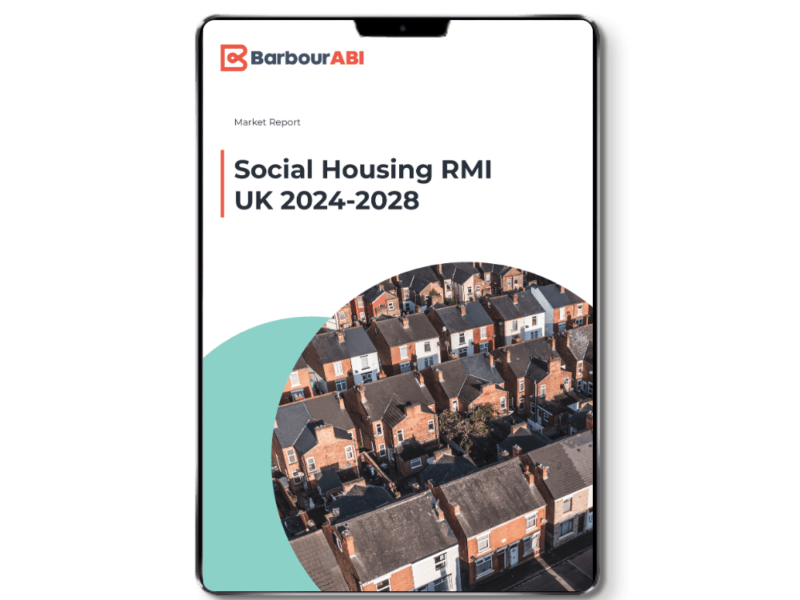Growth projected in the Social Housing RMI Market

The UK social housing RMI market is projected to grow in the next five years, in value terms, at an unprecedented level. The 2nd edition of the UK social housing RMI market report presents our forecast from 2024 to 2028 for the social housing RMI sector. This report focuses on social homes in the UK provided by the following registered providers:
- Local Authorities’ housing departments and ALMOs.
- Not-for-profit registered providers (PRPs) – mostly housing associations but also community trusts.
- For-profit registered providers (FPRPs).
Analysis provided in this report includes:
- Evaluation of the structure and size of the social housing RMI sector in the UK, including data specific to England, Scotland, Wales, and Northern Ireland.
- The distribution of social housing stock and a review of social housing registered providers, including financial profiles of the top housing associations.
- Social housing RMI expenditure trends.
- Regional breakdowns.
- Regulatory landscape and key market drivers.
- Key RMI contracts and recent awards.
Social Housing RMI Market Overview
The social housing RMI market has been particularly impacted by economic uncertainty in 2020. Nonetheless, the market remained resilient and rebounded the following year and has been growing since. This report displays growth in volume and value terms, as the former has been slower than the latter partly due to inflation.
However, trends suggest that RMI investments from social housing registered provider are at an all time high. Changes in regulatory landscape, particularly surrounding health and safety, such as Awaab’s law introduced in 2023, and tenants’ voice, contribute to RMI needs in this sector.
Labour’s Housing Target
The Labour Government announced its plan to build 1.5m dwellings before the end of this parliament. However, labour shortages are likely to challenge this goal in the short term, as this is also seen as a factor delaying growth in the RMI side of the housing sector.
Despite this, the UK social housing stock is in need of RMI work. This is partly due to regulations in place – through which social homes ought to achieve an EPC rating above D by 2035, fix reported hazards such as damp and mould, and ensure decent living standards – but also due to the age of social homes, as a considerable part of them were built prior 1965.
Additionally, tenants’ voice gained strength through the Social Housing White Paper, the Social Housing Regulation Act, and the new Consumer Standards. This report evaluates tenants’ dissatisfaction levels by demographic and social housing provider to understand potential areas of improvement in this sector.
Many researchers have studied the need for the construction of social homes in the UK, with many recommending 50k to 90k new social homes per year. However, historically, RMI output in value terms has been higher than new build output in the social housing sector. This is expected to continue despite the difference in value output narrowing between the two when compared to social new build output and social RMI output twenty years ago.
Regional Breakdown
In terms of social housing stock, the majority is located in England, followed by Scotland, Wales, and Northern Ireland.
Prior to 2005, most social homes were managed by local authorities, but this changed in favour of housing associations, despite the split varying slightly between each UK regions.
Further, regional breakdowns underline that social housing stock tends to be concentrated around large cities, such as London, Cardiff, and Belfast.
Key Players
Housing associations’ expenditures in 2023 and 2024 were particularly large, with some focusing on upgrading bathrooms, kitchens, windows and doors, and energy systems such as Clarion Housing Group and the London & Quadrant Group Housing Trust.
Social housing providers seem to focus on upgrading social dwellings to increase their lifespan and abide to energy efficiency requirements. Some key players identified in this sector include Equans, the Breyer Group, Frotem Solutions, Mears Group, and Wates Construction.
Key procurement platforms identified in this sector include the UK government’s Contract Finder and Find a Tender Service channels, Public Contracts Scotland, Sell2Wales, and eTendersNI.
Recent Posts
- Key Trends and Market Dynamics in the UK Bricks, Blocks & Precast Concrete Sector
- Navigating Market Volatility: The Future of the UK Kitchen and Bathroom Distributors
- UK Kitchen and Bathroom Distribution: Growth, Challenges, and Opportunities
- Diesel Dominance and the Rise of Green Alternatives in the UK Generator Market
- From Diesel to Hybrid: Barbour ABI Maps UK Generator Hire Market Evolution
Categories
Archives
Share
Featured Report
-

Social Housing RMI Market Report UK 2024-2028
£1,499.00 Exc. VAT Add to BasketThe UK Social Housing RMI Market Report 2024-2028 includes a detailed assessment of current trends and developments in the overall market. The market is assessed by type of registered providers, contractors’ output, UK region...


